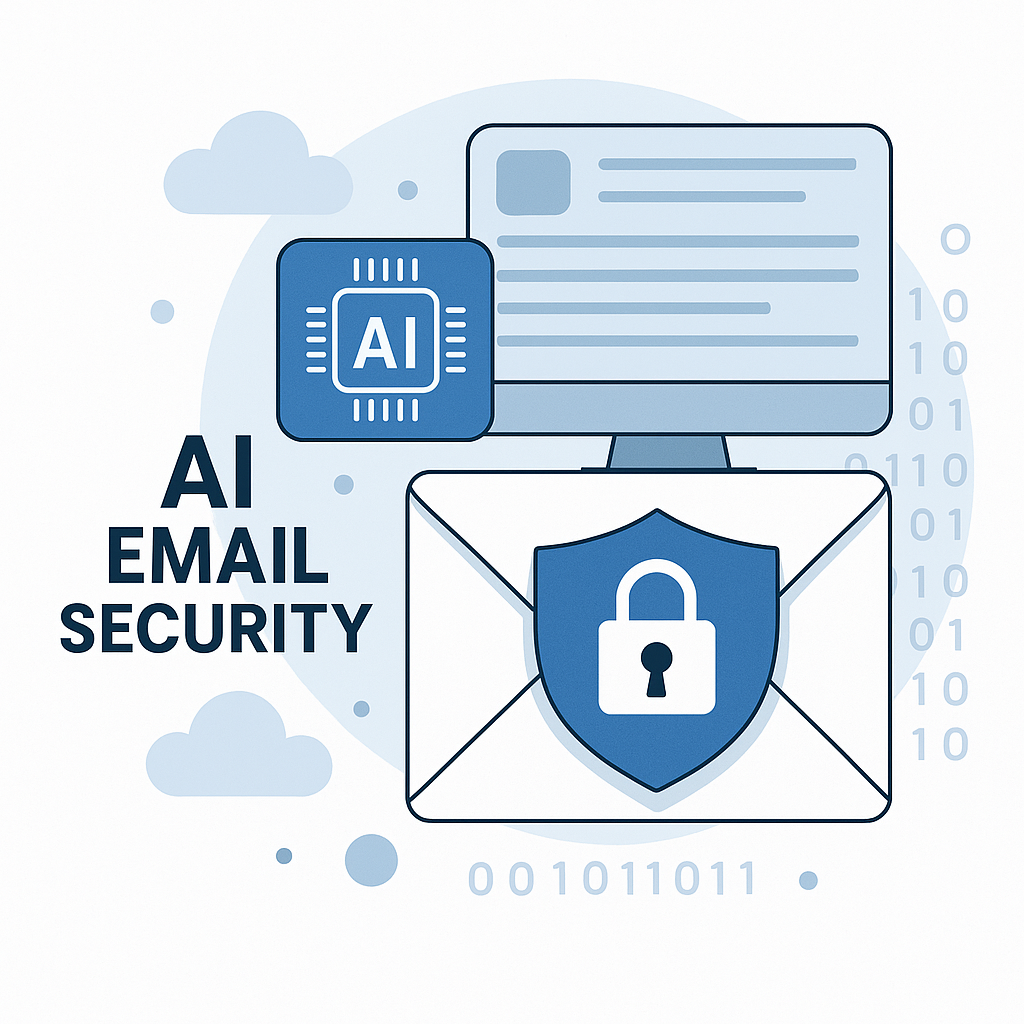AI Email Security: Protect Your Inbox From Threats

Email remains the backbone of modern business communication. It's the digital handshake, the primary channel for collaboration, and often, the first point of contact for clients and partners. However, this indispensable tool is also a primary vector for cyberattacks. The threats are no longer just generic spam; they've evolved into sophisticated, targeted assaults designed to infiltrate systems, steal data, and disrupt operations. From cunning phishing attempts that mimic trusted sources to advanced malware hidden within seemingly innocuous attachments, and the increasingly damaging Business Email Compromise (BEC) scams, the digital landscape is fraught with peril. Traditional security measures, often relying on static signature-based detection, are struggling to keep pace with attackers who constantly innovate. This arms race demands a more intelligent, adaptive, and proactive approach. Enter Artificial Intelligence (AI), which is revolutionizing ai email security, offering a powerful new defense against these persistent and evolving threats.
How AI Revolutionizes Email Security Beyond Traditional Methods
For years, email security solutions relied on a reactive approach. They would identify known threats based on pre-defined signatures or rules – essentially, a digital blacklist. While effective against common, well-understood malware and spam, this method has significant limitations in today's dynamic threat environment. Attackers can easily modify their malware to evade signature detection, craft phishing emails that are nearly indistinguishable from legitimate ones, and launch novel attacks without prior signatures.
AI, particularly machine learning (ML), transforms AI email protection by moving from a reactive, signature-based model to a proactive, behavior-based, and anomaly-detection paradigm. Unlike traditional systems, AI algorithms can analyze vast amounts of data, learn normal patterns of communication, and identify subtle deviations that indicate malicious intent. This means AI can detect threats that have never been seen before – so-called "zero-day" threats – and adapt in real-time as attack methods change. As Abnormal AI puts it, "AI email security refers to the use of AI technologies to safeguard email communication from cyber threats. Unlike static, signature-based tools, AI email security uses advanced email algorithms that can analyze email content, sender reputation, and user behavior to identify and neutralize malicious emails." This adaptive capability is crucial for staying ahead of sophisticated adversaries. The integration of AI into email security solutions offers numerous advantages, including improved accuracy in threat detection and reduced false positives, as AI-driven systems can adapt to evolving cyber threats more effectively.
Key AI Capabilities for Proactive Email Threat Detection (Phishing, Malware, BEC)
AI brings a multi-faceted approach to identifying and neutralizing the most prevalent email-borne threats. Its ability to process and understand context, language, and behavior makes it an invaluable asset.
Advanced Phishing Detection
Phishing remains one of the most common and effective attack vectors. Attackers use social engineering tactics to trick recipients into revealing sensitive information, clicking malicious links, or downloading malware. AI excels at phishing detection AI by going beyond simple keyword matching or URL blacklisting.
- Natural Language Processing (NLP): AI can analyze the sentiment, tone, and context of email content. It can detect urgent language, unusual requests, grammatical errors often found in mass phishing campaigns, or the subtle linguistic nuances in highly targeted spear-phishing attacks. For instance, an AI might flag an email seemingly from a CEO asking for an urgent wire transfer due to its unusual phrasing, the sender's deviation from typical communication patterns, or the specific request itself, even if the sender's email address appears legitimate.
- URL and Domain Analysis: AI can analyze links more deeply, not just by checking against blacklists, but by examining URL structure, domain age, reputation, and any suspicious redirection patterns. It can also detect subtle domain spoofing techniques that trick the human eye.
- Sender Reputation and Behavior: AI builds a profile of sender behavior over time. If an email comes from a known contact but exhibits unusual characteristics (e.g., sent at an odd hour, different writing style, contains an unexpected attachment), AI can flag it. This is crucial for combating sophisticated phishing detection AI that uses compromised accounts or spoofed domains. To learn more about how AI specifically combats phishing, explore our article on AI Phishing: How AI Secures Your Inbox.
Malware Detection and Prevention
Traditional antivirus relies on known malware signatures. However, modern malware is often polymorphic, meaning it changes its code with each infection, rendering signature-based detection ineffective. AI tackles this challenge head-on:
- Behavioral Analysis: AI can analyze the behavior of attachments and embedded code before they execute. By running suspicious files in a secure virtual environment (sandboxing), AI can observe their actions – are they trying to encrypt files, connect to known malicious servers, or modify system settings? If the behavior matches known malicious patterns or exhibits suspicious anomalies, the AI can block the attachment.
- Pattern Recognition in Code: AI can identify malicious code patterns and obfuscation techniques, even in previously unseen malware variants. This allows for the detection of zero-day threats and advanced persistent threats (APTs).
- Attachment Type Analysis: AI can assess the risk associated with different attachment types and content, flagging unusual or potentially dangerous file formats or embedded objects that might contain malicious scripts.
Business Email Compromise (BEC) Prevention
BEC attacks are particularly insidious because they often bypass technical defenses by relying on social engineering and impersonation, often without any malware. These attacks can lead to significant financial losses. AI is instrumental in business email compromise prevention:
- Impersonation Detection: AI can detect sophisticated impersonation attempts by analyzing slight variations in sender email addresses (e.g.,
[email protected]instead of[email protected]), display name spoofing, and deviations from established communication channels. - Contextual Analysis of Requests: AI can analyze the context of requests within an email. For instance, if an email from a known executive suddenly asks for an urgent wire transfer to a new, unfamiliar bank account, or requests gift cards, AI can flag this as highly suspicious, especially if it deviates from the executive's typical financial transaction patterns. Guardian Digital highlights that "AI and Machine Learning offer a multitude of ways to enhance email security. These technologies can analyze email patterns, content, and user behavior to effectively identify and filter out spam, phishing, and other malicious content."
- Transaction Pattern Analysis: For finance departments, AI can monitor transaction requests within emails, comparing them against historical data and known legitimate processes to identify anomalies indicative of BEC. This proactive approach is crucial for business email compromise prevention.
AI-Powered Anomaly Detection and Behavioral Analysis in Emails
Perhaps the most significant advantage AI brings to email security is its ability to perform advanced anomaly detection and behavioral analysis. Traditional security tools are like a bouncer checking IDs against a pre-approved list. AI is like a seasoned detective who understands the usual comings and goings, notices who's acting strangely, and can spot someone trying to blend in by subtly altering their appearance.
AI establishes a baseline of "normal" behavior for your organization and individual users. This includes:
- Sender Patterns: Who typically emails whom? What time of day do certain people usually communicate?
- Recipient Lists: Are emails being sent to an unusually large or unusual group of recipients?
- Content Style: Does the language, tone, and structure of an email match the sender's typical communication style?
- Attachment Types and Sizes: Are the attachments typical for the sender and recipient context?
- Frequency and Volume: Is there an unusual spike in emails from a particular source or to a specific user?
When an email deviates from this established normal, AI flags it as a potential threat. For example:
- An email from your CFO arrives at 2 AM on a Sunday, asking you to urgently purchase gift cards. This deviates from normal working hours and typical communication patterns.
- An email from a known vendor suddenly uses a slightly different domain name and requests updated banking details for an upcoming payment. AI can spot the domain anomaly and the deviation from the vendor's typical payment processing procedures.
- A colleague who normally sends concise, direct emails suddenly sends a lengthy, emotionally charged message requesting sensitive company data. AI can detect this shift in communication style.
This continuous learning and deviation detection is a core component of email threat intelligence. By understanding what's normal, AI can identify the subtle indicators of sophisticated attacks that might otherwise go unnoticed. As Acronis notes, "Artificial Intelligence (AI) is pivotal in email security because it analyzes vast amounts of data and identifies patterns that human operators might miss. This technology enables email security systems to detect threats that would otherwise go undetected." This capability significantly strengthens AI cybersecurity for email defenses.
Automated Response and Remediation: AI's Role in Minimizing Damage
Detecting a threat is only half the battle. The speed and effectiveness of the response are critical in minimizing potential damage. AI-powered email security solutions excel in automating these crucial steps, acting as an intelligent first responder.
Once AI identifies a suspicious email or attachment, it can trigger a range of automated actions:
- Quarantine Suspicious Emails: Instead of delivering a potentially malicious email to the user's inbox, AI can automatically move it to a secure quarantine area for review.
- Block Malicious Senders: The system can automatically block senders exhibiting consistently malicious behavior, preventing further communication.
- Alert IT Security Teams: For high-confidence threats or complex anomalies, AI can generate immediate alerts for human security analysts to investigate.
- Notify Users: Users can be automatically notified if an email they received has been flagged and quarantined, explaining why (e.g., "This email was flagged as a potential phishing attempt").
- Remediate Compromised Accounts: In cases where an account is suspected of being compromised, AI can trigger automated steps like forcing a password reset or temporarily disabling access.
- Scan and Remediate Existing Emails: Some advanced systems can scan mailboxes for previously delivered threats that were missed and automatically remediate them.
The power of automation lies in speed and consistency. AI can react to threats in milliseconds, far faster than any human could. This rapid response is essential for containing malware outbreaks or preventing sensitive data from being exfiltrated in a BEC attack. A robust secure email gateway powered by AI will integrate these automated response capabilities, acting as a vital layer of defense that protects your organization's digital assets and maintains operational continuity.
Ensuring Data Privacy and Compliance with AI Email Security
In today's regulatory environment, protecting sensitive data is not just good practice; it's a legal and ethical imperative. AI-powered email security plays a crucial role in safeguarding data privacy in email and helping organizations meet compliance requirements like GDPR, HIPAA, CCPA, and others.
Here's how AI contributes:
- Data Loss Prevention (DLP): AI enhances DLP capabilities by intelligently identifying and classifying sensitive data within emails, such as credit card numbers, social security numbers, protected health information (PHI), or confidential company intellectual property. It can then prevent these emails from being sent externally or flag them for review, thus preventing accidental or malicious data leaks.
- PII Identification and Redaction: AI can scan incoming and outgoing emails to identify Personally Identifiable Information (PII) or other sensitive data. In some workflows, AI can even automatically redact this information from emails before they are stored or forwarded, ensuring compliance with privacy regulations.
- Compliance Monitoring: AI can continuously monitor email content for potential compliance violations, such as the inappropriate sharing of sensitive information, use of non-compliant language, or adherence to data retention policies.
- Threat Intelligence for Compliance: By providing robust email threat intelligence, AI helps organizations understand the types of attacks they face, which is crucial for risk assessments and for implementing appropriate security controls mandated by compliance frameworks.
- Reducing False Positives: Traditional security tools often generate numerous false positives, requiring significant manual effort to review. AI's improved accuracy in threat detection reduces these false positives, allowing security teams to focus their efforts on genuine threats and ensuring that legitimate, compliant communications are not inadvertently blocked.
By integrating AI into your email security strategy, you not only fortify your defenses against cyber threats but also build a more resilient framework for data privacy in email, ensuring that your organization remains compliant and trustworthy. The integration of AI into email security solutions offers numerous advantages, including improved accuracy in threat detection and reduced false positives, as AI-driven systems can adapt to evolving cyber threats more effectively.
Integrating AI Security Features into Your Email Workflow
Adopting AI-driven email security isn't just about choosing a new tool; it's about integrating intelligence into your daily operations. For busy professionals and IT departments, the goal is to enhance security without creating significant friction or adding to workloads.
Here's how to approach integration:
- Assess Your Current Security Posture: Understand your existing email security measures. Are they sufficient? Where are the gaps? This assessment will guide your AI adoption strategy.
- Choose the Right AI Solution: Look for solutions that offer comprehensive protection against phishing, malware, and BEC. Key features to consider include:
- Ease of Integration: Does it seamlessly integrate with your existing email platform (e.g., Microsoft 365, Google Workspace)?
- User Experience: Is it intuitive for end-users, or does it require extensive training?
- Customization: Can it be tailored to your organization's specific risk profile and communication patterns?
- Automation Capabilities: How effectively does it automate threat detection and response?
- Reporting and Analytics: Does it provide clear insights into threats and the effectiveness of the security measures?
- Leverage AI for Workflow Enhancement: Modern AI tools can do more than just protect. For professionals looking to streamline their email management and enhance security, tools like an ai executive assistant can offer integrated solutions that not only manage your inbox efficiently but also bolster your defenses against emerging email threats. Such assistants can help prioritize messages, draft replies, and manage scheduling, all while operating with an underlying awareness of security best practices.
- Employee Training: While AI handles much of the heavy lifting, user awareness remains critical. Train your employees on the importance of email security, how to recognize potential threats, and what to do if they encounter something suspicious. Even with advanced AI, a vigilant human element is a powerful complement.
- Phased Rollout: Consider a phased rollout, starting with a pilot group to test the solution and gather feedback before a full organizational deployment. This allows for adjustments and ensures a smoother transition.
By thoughtfully integrating AI security features, businesses can transform their email from a potential vulnerability into a more secure and productive communication channel. This approach aligns with broader efforts to manage and optimize digital workflows, similar to how one might aim to Conquer My Inbox: Smart Triage & Prioritization for greater efficiency.
Conclusion: The Future of Secure, AI-Enhanced Email Communication
The digital battleground for business communication is constantly shifting, with email remaining a prime target for cybercriminals. Traditional security methods, while foundational, are no longer sufficient to combat the evolving sophistication of phishing, malware, and BEC attacks. Artificial Intelligence has emerged not just as an enhancement but as a necessity for robust ai email security.
AI's ability to analyze behavior, detect anomalies, process natural language, and adapt in real-time provides a proactive defense that static, signature-based systems simply cannot match. It empowers organizations with advanced phishing detection AI, effective business email compromise prevention, and intelligent malware defense, all while reinforcing data privacy in email and compliance efforts. By integrating AI into your email security strategy, you gain a powerful ally in protecting your organization's most critical communication channel, ensuring a more secure and productive work environment.
As AI technology continues to advance, its role in email security will only grow, offering increasingly sophisticated methods for threat detection, response, and overall digital protection. Embracing AI-powered email security is an investment in the resilience and integrity of your business communications for today and the future. Evaluate your current defenses, explore AI-driven solutions, and take a proactive step towards safeguarding your inbox.



